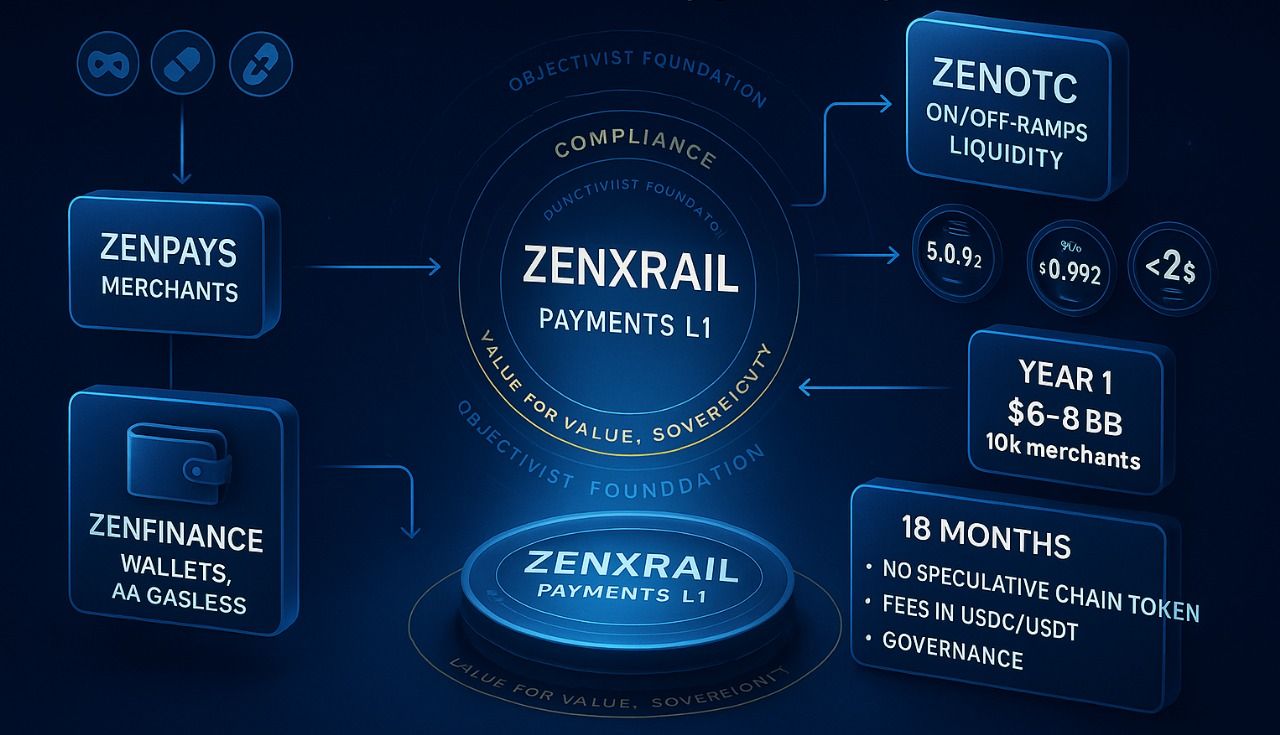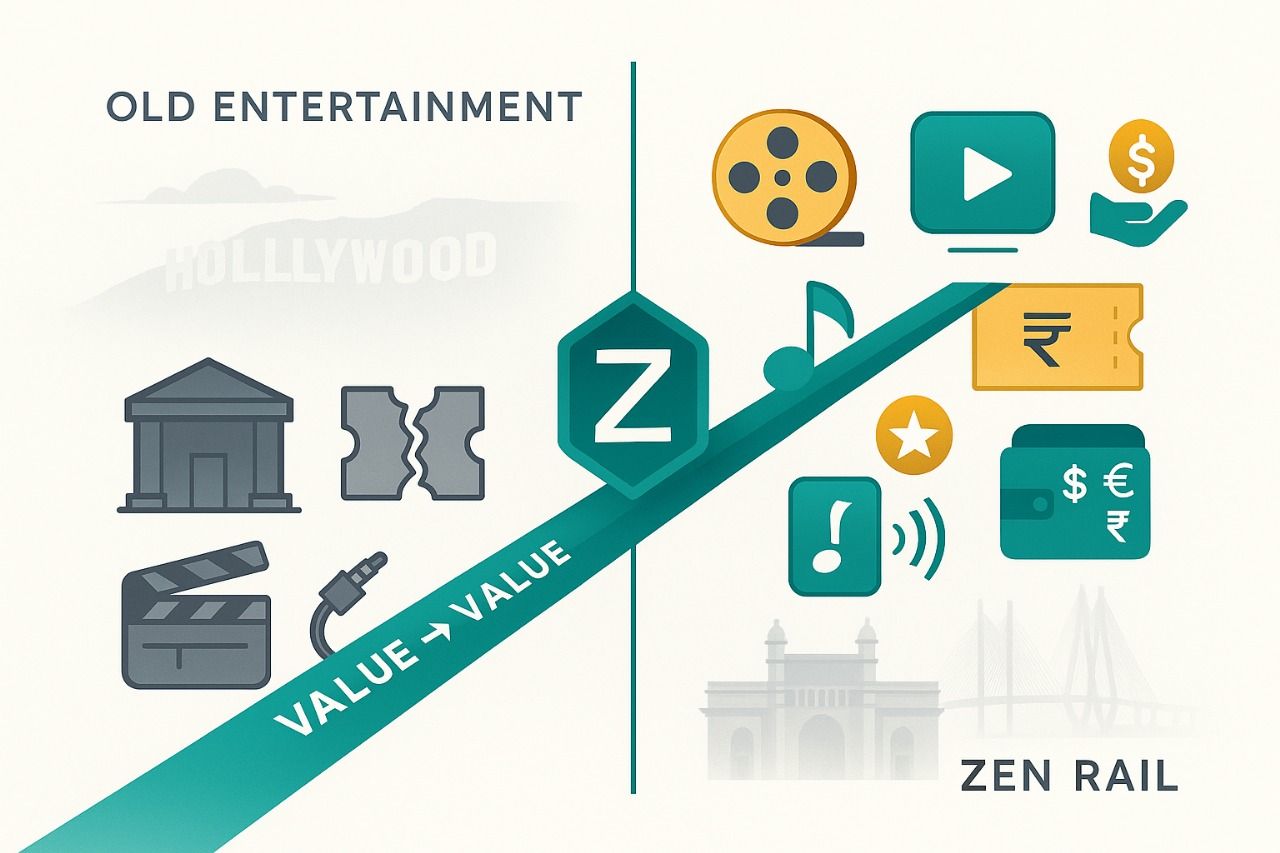
I didn’t come to crypto to rent space on someone else’s network. I came to build.
Build products that don’t beg permission. Build rails that don’t discriminate. Build systems where value trades for value - and where the creators of value keep the fruits of their work.
That is the core ethos behind ZenX and ZenPays - and now, Atlas Rail (ZenXRail): a payments-first rail designed to carry global, USD-stablecoin commerce at merchant scale. It’s the natural culmination of what we’ve already assembled: merchants through ZenPays, liquidity through ZenOTC, wallets and DeFi through ZenFinance, and exchange infrastructure through ZenX. The last missing piece is the rail itself - and we’re going to own it.
The market is already telling us this is the right direction. Payments “giants” are migrating on-chain. Issuers are standing up their own networks. Banks are piloting programmable dollar rails. The message is simple: the moat is no longer a single product advantage - it’s owning the four layers at once: the merchant, the on/off-ramp, the wallet, and the rail. ZenX is already three-quarters of the way there; Atlas Rail completes the loop.
Why We’re Building a Rail (and Why Now)
Renting the rails makes you hostage to someone else’s rules. You inherit their costs, their data model, their risk policy, and eventually, their veto power over your business. That’s tolerable when you’re small or when your use case fits a platform’s “acceptable” profile. It becomes suffocating the moment you try to onboard cross-border, high-risk, or non-traditional merchants - the VERY entrepreneurs who build the most interesting businesses.
Atlas Rail exists to flip the default. Instead of “apply, wait, and hope,” we build rails that assume commercial freedom as the baseline and layer controls in a way that preserves property rights: your money, your data, your terms. This is not a rhetorical stance; it’s a practical one. If you want 24/7 global settle, chargeback-resistant instruments, sub-second authorizations, and programmable payout logic, you don’t get there by pleading with legacy networks. You get there by building a merchant-grade chain that speaks payments natively.
The Four-Part Playbook (and How We Already Execute It)
1) Own the merchants (ZenPays).
ZenPays is where merchants, especially those deemed “high-risk”, plug in. We give them a drop-in checkout, stablecoin acceptance, cards and local methods in one interface, and full-stack onboarding. We also support merchant-of-record structures and FBO-style sub-accounts for clean ledgers and auditability. Pricing is merchant-rational: basis points, not mystery fees; cheaper domestic stablecoin acceptance and sensible cross-border rates.
2) Control the on/off-ramps (ZenOTC + banks).
Our OTC desk already moves institutional size in USDT/USDC/BTC. We’ll formalize corridors (SWIFT, SEPA, UAE local rails) and maintain pooled treasury capacity so that businesses can sweep from stablecoin balances into local fiat - and back - without drama. Where it’s advantageous, a Cayman SPC structure gives us segregated portfolios for float and merchant advances.
3) Control the wallets (ZenFinance).
On the business side, custodial wallets with role-based permissions, spend policies, and programmatic payouts. On the consumer side, embedded, recoverable, non-custodial wallets that “just work” with passkeys - no seed phrases at checkout. This is how we remove friction without removing sovereignty.
4) Control the rails (Atlas Rail / ZenXRail).
The rail is the glue. We route ZenPays stablecoin traffic natively over Atlas Rail, net multi-order flows for fee savings, and only bridge at the edges when we must. That’s how we deliver card-like UX without card-like overhead.
Stablecoins Are Infrastructure, Not Theater
By 2030, 99% of stablecoin volume won’t be retail swipes at coffee shops or cross-border gimmicks. It will be institutional - professional traders, funds, and market makers rebalancing liquidity at scale.
Stablecoins aren’t here to “replace credit cards.” They already replace correspondent banking, slow wire transfers, and collateral bottlenecks. They’ve become the plumbing that allows capital to move instantly across markets and jurisdictions.
The challenge ahead isn’t retail adoption. It’s engineering stablecoins for the systems where they’re already dominant: clearing, settlement, risk management, and liquidity transfer.
We stopped mistaking them for consumer apps. We started designing them as financial infrastructure. Because that’s what they are - the rails on which tomorrow’s markets are already running.
Atlas Rail: What It Is (and What It Isn’t)
Atlas Rail is a payments-first settlement rail with sub-second user experience and deterministic finality at merchant scale. The target user is a merchant or marketplace with thousands (or millions) of daily transactions, subscription billing, refunds, partial captures, and complex payout trees. The target instrument is the dollar - specifically USD stablecoins - because that’s what global commerce prefers today.
The high-level goals are unambiguous:
- Sub-second to ~2s finality
- Fees under ~0.2¢ per transaction at scale
- Merchant-grade auth/capture/refund primitives
- Programmable compliance and payouts
- Native FX at the point of payment
Architecture: We’ll run Atlas Rail as a sovereign rollup that inherits Ethereum settlement, combining a production-ready stack (e.g., OP Stack + EigenDA) with a payments-optimized mempool. This gives us the best of both worlds: Ethereum-grade security and merchant-grade throughput, with a rapid time-to-market and predictable costs.
Dollar-denominated gas from day one.
Merchants should never worry about volatile fees. Atlas Rail uses USDC/USDT as gas, starting with USDC-as-gas and adding USDT-as-gas where demand requires. That keeps pricing intuitive and auditable - no FX surprises sneaking into your operational costs.
A payments mempool, not a trader’s playground.
We’ll set priority lanes for authorization/capture, recurring invoices, and subscription batches, and use batch auctions to minimize extractive MEV against retail flows. Payments have very different needs than trading; the rail should reflect that reality.
Account abstraction for a “just works” checkout.
Passkeys, per-transaction spend limits, session keys, sponsored gas for first purchases: these are table stakes for mainstream commerce. We’ll ship them at the protocol edge, not as an afterthought in a dApp.
Merchant-Native Primitives (Built In, Not Bolted On)
Card networks weren’t built for crypto; most chains weren’t built for merchants. Atlas Rail closes that gap with primitives that mirror what merchants actually do:
- Auth/Capture on-chain. Pre-authorize the amount at checkout, capture on fulfillment, support partial captures, voids, and refunds. That’s the language of commerce; and it belongs on-chain if we expect merchants to switch.
- Atomic FX at checkout. If the buyer’s wallet holds non-USD assets, swap into the merchant’s chosen settlement currency (USD/EUR/AED) in one transaction, using liquidity from ZenFinance or whitelisted venues.
- Instant payouts. Program T+0 or instant payout policies to FBO sub-accounts or external bank rails so CFOs control treasury risk in real time.
- Risk hooks at block inclusion. Fraud and velocity checks become preconditions for inclusion in a block, not just post-facto analytics. That means fewer bad transactions and cleaner ledgers.
Data & Compliance: Property Rights Come First
Our stance is simple: your data is your property. Atlas Rail encodes that principle:
- Merchant Data Property Rights. Zen licenses data for service delivery; we don’t “own” it. Default is opt-out from cross-merchant profiling.
- Selective-disclosure credentials. Users and businesses can prove KYC/AML status without leaking everything, using verifiable credentials and proofs (PoKYC). That makes compliance programmable and privacy-preserving.
- Travel Rule, correctly scoped. Trigger it only where the law actually applies (VASP↔VASP), not for peer-to-peer transactions where it doesn’t.
- Jurisdiction stack by design. UAE (VARA/ADGM) for VASP/payment-token permissions and Travel Rule gateways; Cayman SPC for treasury and segregated risk; EU via partner EMI; US via sponsor or state coverage with stablecoin-compliant regimes as they formalize.
This is compliance with integrity, NOT censorship disguised as safety.
No Speculative Chain Token. No Rent-Seeking.
Atlas Rail won’t ask you to hold a volatile governance token to use the network. Fees are paid in USD stablecoins, and we’ll publish a transparent basis-points schedule for payment flows. For high-volume merchants, fee credits act like transferable coupons; which are useful for planning, not a backdoor security. We’ll also rebate a portion of order-flow value back to top merchants to neutralize MEV incentives against payments. Governance is pragmatic: merchants and validators set technical parameters; one-merchant-one-seat on payment policy; stake-weighted for infrastructure scope.
We’re not here to extract rent from the very businesses we claim to empower.
Targets, Not Hype
We’ll measure ourselves like a payments network, not a meme coin.
- Throughput: bursts of 5-10k TPS with p95 finality ≤2s and p95 fees ≤$0.002.
- Reliability: 99.99% uptime; fraud losses ≤4 bps on stablecoin transactions.
- Year-one operating KPIs: 1k merchants live (200 enterprise, 800 SMB), $0.6–0.8B GPV routed over Atlas Rail, ~38 bps blended take rate, >85% cohort retention at Q+2, and ≥35% reduction in on-chain transactions via netting (versus naïve per-order settle).
These aren’t slogans. They are engineering and go-to-market constraints that focus execution.
The Build Plan (18 Months to Scale)
A plan isn’t a wish list; it’s a schedule of commitments.
- Phase 0 (now through Oct 2025): finalize architecture (OP Stack + EigenDA as primary), confirm USDC/USDT-as-gas with issuers, lock three payout banks across UAE/EU/US, and pilot auth/capture with three design partners in high-risk categories.
- Phase 1 (Nov 2025–Feb 2026): bring up the ZR-1 testnet (working name), ship ZenPays v2 SDKs across web/iOS/Android with stablecoin + cards, and stand up the compliance gateway (Travel Rule provider integration).
- Phase 2 (Mar–Jun 2026): Mainnet-A for enterprise: gate-launch with 50 enterprises, instant payouts via FBOs, cross-border corridors UAE↔EU↔US, atomic FX through ZenFinance pools, and production circuit breakers.
- Phase 3 (Jul–Nov 2026): Mainnet-B for scale: open onboarding, fee-credit programs, ISV partnerships, and deposit-token interop with a global bank when viable. Team size ~45 across protocol, devex, payments, risk/AI, SRE, and compliance; total 18-month spend estimated at $18–28M.
We will ship where the value is greatest first: high-risk, cross-border merchants who are priced out - or shut out - by legacy rails.
High-Risk Is Not a Dirty Word
“High-risk” in legacy payments is often a euphemism for non-conforming: adult creators operating legally in their jurisdictions, gaming platforms with global user bases, nutraceutical sellers that fail an opaque underwriting script, crypto-native businesses that don’t fit a bank’s political risk profile. These are not bad actors by default; they are simply builders who don’t fit a decades-old box.
Atlas Rail exists for them:
- Frictionless onboarding through ZenPays with KYC that respects the business model and jurisdictional reality; not a box-checking pantomime.
- Predictable acceptance with low, stable fees tied to objective risk controls, not arbitrary flags.
- Refunds and chargebacks handled on-chain where possible, with auditable logic instead of support-queue roulette.
- Instant settlement into stablecoins or fiat corridors so working capital turns faster, and growth compounds sooner.
This is not about “inclusion” as charity. It’s about recognition: if you create value and operate lawfully, the rail should carry your commerce. Period.
Risk, Acknowledged and Engineered
We’re not naïve about risks. We’re explicit about them; and the mitigations.
- Regulatory drift. We keep the network focused on stablecoin-as-gas and avoid launching a native volatile token. For fiat interfaces, we use EMI/sponsor coverage where appropriate and design for modular compliance so rules can be applied where they legally apply and nowhere else.
- Liquidity crunch. We pre-fund corridors, maintain OTC lines, and implement circuit breakers on FX to protect merchants during stress.
- MEV/latency attacks. We run private order-flow lanes for payments and batch auctions to neutralize timing games.
- Adoption friction. We deliver card-like features (auth/capture, refunds), fiat settlement by default where required, and zero-code installs for mainstream merchants.
Risk management is not moral theater for us. It’s engineering.
What Makes Us Different (Reality in Practice)
Reality isn’t a sticker on our deck. It’s the operating system.
- No rent extraction. We charge transparently for real services rendered. If we create more value per basis point, we win. If not, we deserve to lose.
- No moral claims; only performance. Cheaper, faster, programmable settlement that respects property rights in money and data - or we don’t ship it.
- Open competition. We interoperate where it benefits merchants; we compete where we can deliver a better outcome. There’s no entitlement to your traffic: only the obligation to earn it.
That’s what “value for value” means when the rubber meets the road.
Naming the Future
We’ll ship under Atlas Rail (ZenXRail) - a silent, respectful nod to the builders who keep the world moving and to the network that will carry their commerce. Alternatives like ZenRail and ZenNet are on the table, but for now, Atlas captures the intent: bear the load of global commerce without asking for permission.
What Success Looks Like
- A creator in Manila, a prop-house in Lagos, and a luxury developer in Dubai can all settle in USD stablecoins with sub-second UX, pay cents (not dollars) in fees, and receive programmable payouts to their ledger or bank corridor on their schedule.
- A marketplace can pre-authorize at checkout, fulfill later, partially capture, and refund without touching a centralized dispute oracle. It’s commerce logic, on-chain.
- CFOs can set T+0 settlement, with atomic FX into their preferred currency, and run a clean, real-time cash view.
- Compliance teams can prove what the law requires and nothing more, using selective-disclosure credentials; Travel Rule triggers only where it legally applies.
- Merchants see transparent pricing and MEV rebates where appropriate. No hidden tolls. No back-door rent.
At that point, we’re not “doing crypto payments.” We’re operating a global settlement network that treats entrepreneurs as adults and their businesses as worthy of respect.
The Pledge
I’m building Atlas Rail for the same reason I started in crypto a few months ago: because a free person has the right to trade the values they create, with whom they choose, on terms they choose. Because sovereignty without practical tools is theater, and tools without a moral center end up serving the censor, not the creator.
ZenPays, ZenOTC, ZenFinance, and ZenX gave us the pieces. Atlas Rail connects them into a self-contained, merchant-grade loop that doesn’t ask for permission to exist. The world is moving toward rails that are programmable, dollar-denominated, and always-on. We will not ask to borrow them. We will build them; and we will do it in a way that honors the only ethic worthy of builders: value for value.
If you move money, you’ll be competing on these rails.
I intend to build the ones you’ll want to run on.




